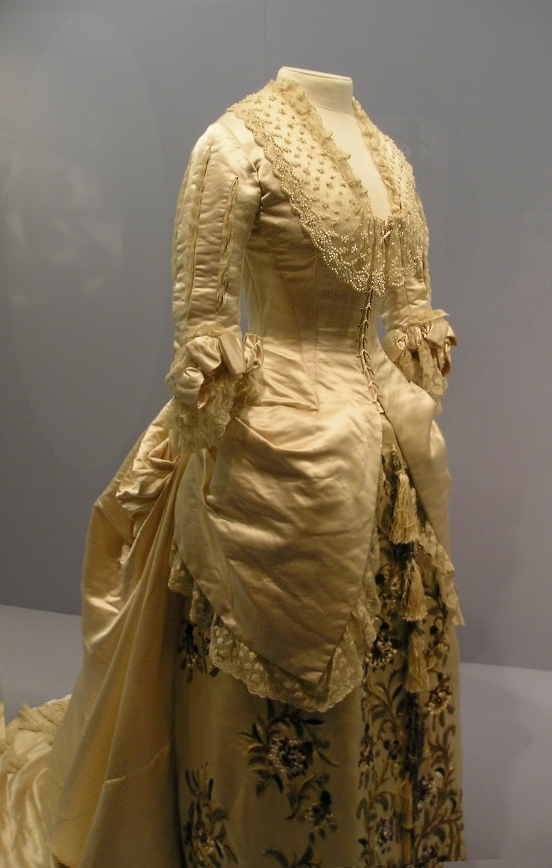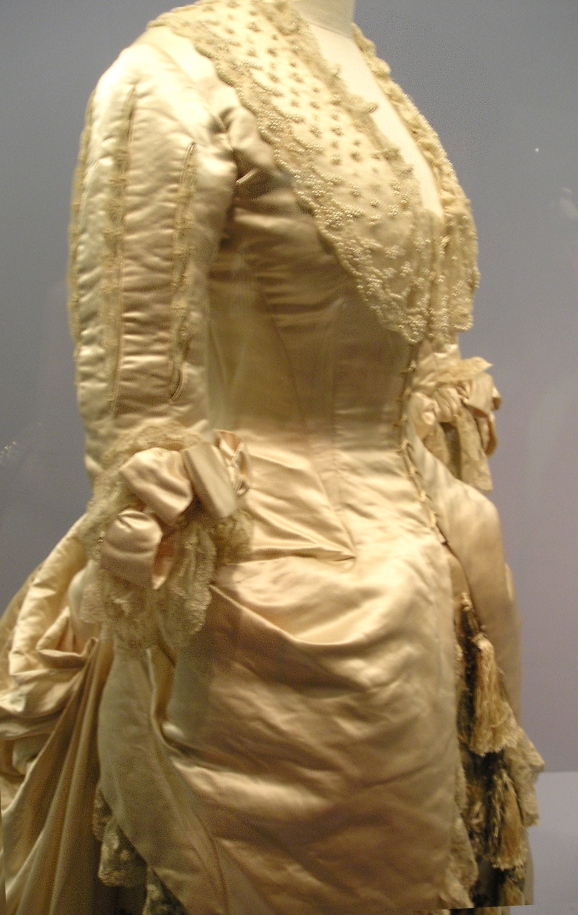In the historic South Kensington district of London lies one of fashion history’s greatest monuments. It is called the Victoria & Albert Museum, and its name conjours up images of the ultimate collection of evening wear. This museum houses over 28,000 articles of clothing, shoes, and accessories, many of which date back to the year 1700 or before. I had the privilege of studying in the Victoria & Albert Museum in the fall of 2009, and spent many blissful hours poring over the breathtaking ball gowns, wedding dresses, and historical costumes. But for those of you who haven’t yet been to the V&A yourself, I wanted to post a few of my favorite garments that I studied there.
Note: The museum doesn’t allow photographers to use a camera flash, so the pictures aren’t as clear as I would like.

This magnificent 1959 evening dress, made of bright pink silk taffeta and organza, has an elegant fitted bodice with petal or tulip pleating in the front and back of the skirt. The hemline in front is mid-calf length, then dips around to the back where it just touches the ground. For the bouffant look of the skirt, the French designer Jacques Heim attached a petticoat with eleven layers of matching net or crinoline. Such a fun, poufy skirt! It must have been a grand occasion that the original owner commissioned this dress for.
In the back of the gown we see unusual tulip pleating, which definitely adds to the style of this 1950s formal dress. I love how the skirt barely drapes across the floor for a slight train effect. Depending on the height of the woman who wore it, this may not have been the case, especially if she was wearing high heels. With the fitted bodice and full skirt, this gown is a perfect example of the fashionable 1950s shape.
This masterpiece was designed by the legendary Charles Worth, often called the “Father of Modern Couture”. It was Worth who reinvented Victorian fashion from the round hoopskirt look of the 1850s-70s, to the more slender “princess” style dress of the 1880s. Women gave up their wide skirt silhouettes in favor of the slim, fitted 1880s skirts with exaggerated bustles in the back.
These bustles were designed of boning and canvas, which was sometimes padded with fabric or even a coat underneath to achieve the desirable look seen on fashion plates of the era. Sleeves went from flared to fitted, with most dresses sporting ¾ length sleeves trimmed with a frill of lace. Nearly any day dress of the period had a fitted bodice topped with a high-neck collar, which was frequently edged with lace as well. For the first time in decades, gowns were again made in one piece, unlike the two piece styles of the 1850s-1870s which usually had separate bodices and skirts.
This gown, made at the very start of the decade, was a sumptuous concoction of creamy silk duchesse satin, trimmed with hand-embroidered floral designs, yards of gathered ivory bobbin lace, wide silk ribbon bows, and hundreds of tiny pearls. You can see the slashing down the sleeves exposing the tulle puffing behind, and the lacing closure down the front of the bodice. I absolutely love the exquisite tulle collar embroidered with an ornate scalloped pearl design!

But by far my favorite element of this gown is the train… First, the duchesse satin is finished with a scalloped hem. Next, they attached a ruffle of bobbin lace following the curve of the hemline. And finally, this masterpiece was finished off with a ruffle of pleated silk extending beyond the lace. Absolutely exquisite! The caption for this gown on display read:
“Evening Dress by Charles Frederick Worth – 1881. Worth was a Paris based couturier who turned dressmaking into an art form. He designed sumptuous gowns famed for their boldly patterned silks, lavish ornament, and innovative used of fabrics. They became status symbols, and fashion clients from across the world flocked to his salon. Mrs. Granville Alexander, daughter of the U.S. sewing machine pioneer Isaac Singer wore this dress. – Satin embroidered with silk, chenille, and beads, trimmed with machine lace.”

I fell in love with this dress from the moment I spotted it. I call it the “Victorian Candy Cane Gown” because of the unique pink and white stripes. With its simple A-line skirt, perfectly fitted bodice, ruching at the bust, and wide cap sleeves, it defines the quintessential Victorian silhouette. The V&A estimates that this dress was worn between 1895 and 1900. The whimsical color combination and gold trim make me think of a sumptuous Nutcracker ball at Christmas… You can view a detailed image of this gown here.
Till next time!
Katrina







[…] of my life, this would probably be it! I shared some glorious silk ball gowns during my last post, but there are too many striking pieces in the V&A collection to not add some more pictures! […]
One of my favorite museums as well. Planning to take a group there in spring 2012 as part of a textile and fashion tour.
My favorite collection of all time. I have had the priviledge of a behind the scenes tour of their storage rooms with an acquaintance of mine. Organizing a similar event this coming spring of 2012.
[…] of my time. : ) I love looking at Edwardian costumes! (When I spent my first few minutes in the Victoria & Albert Museum, I decided I would like to get lost in there and never come […]
[…] I won’t claim that this skirt is completely accurate for an Edwardian petticoat, but I wanted to make something that could pass for either century. Below is a close-up of the material, which reminds me very distinctly of something you would see at the Victoria & Albert Museum. […]